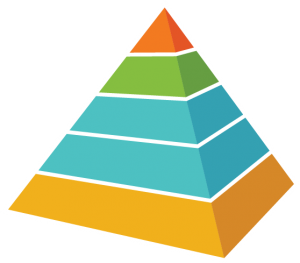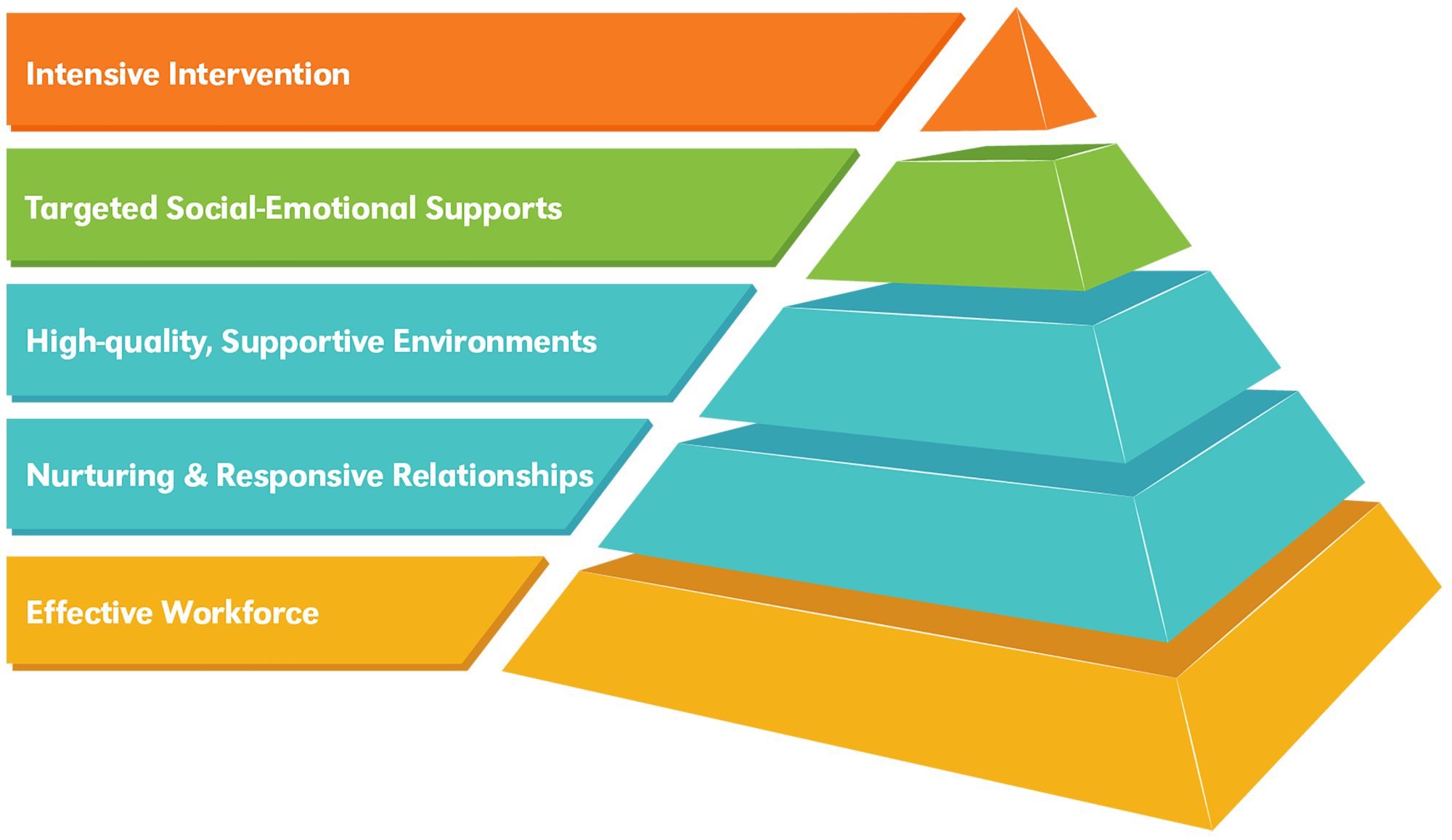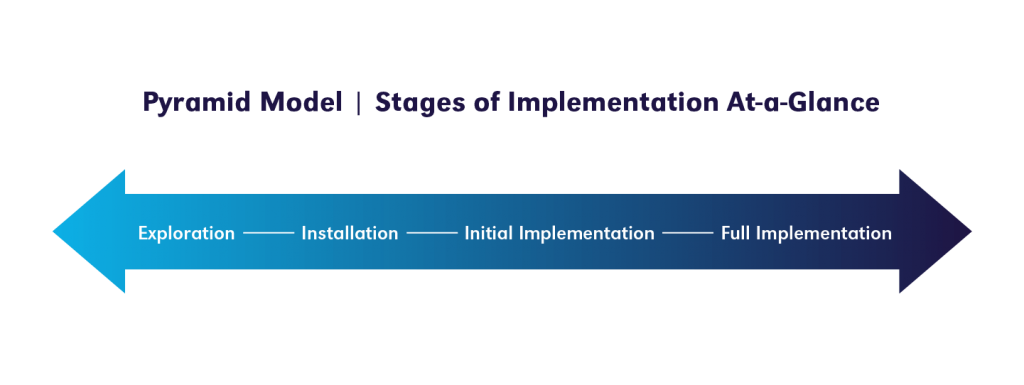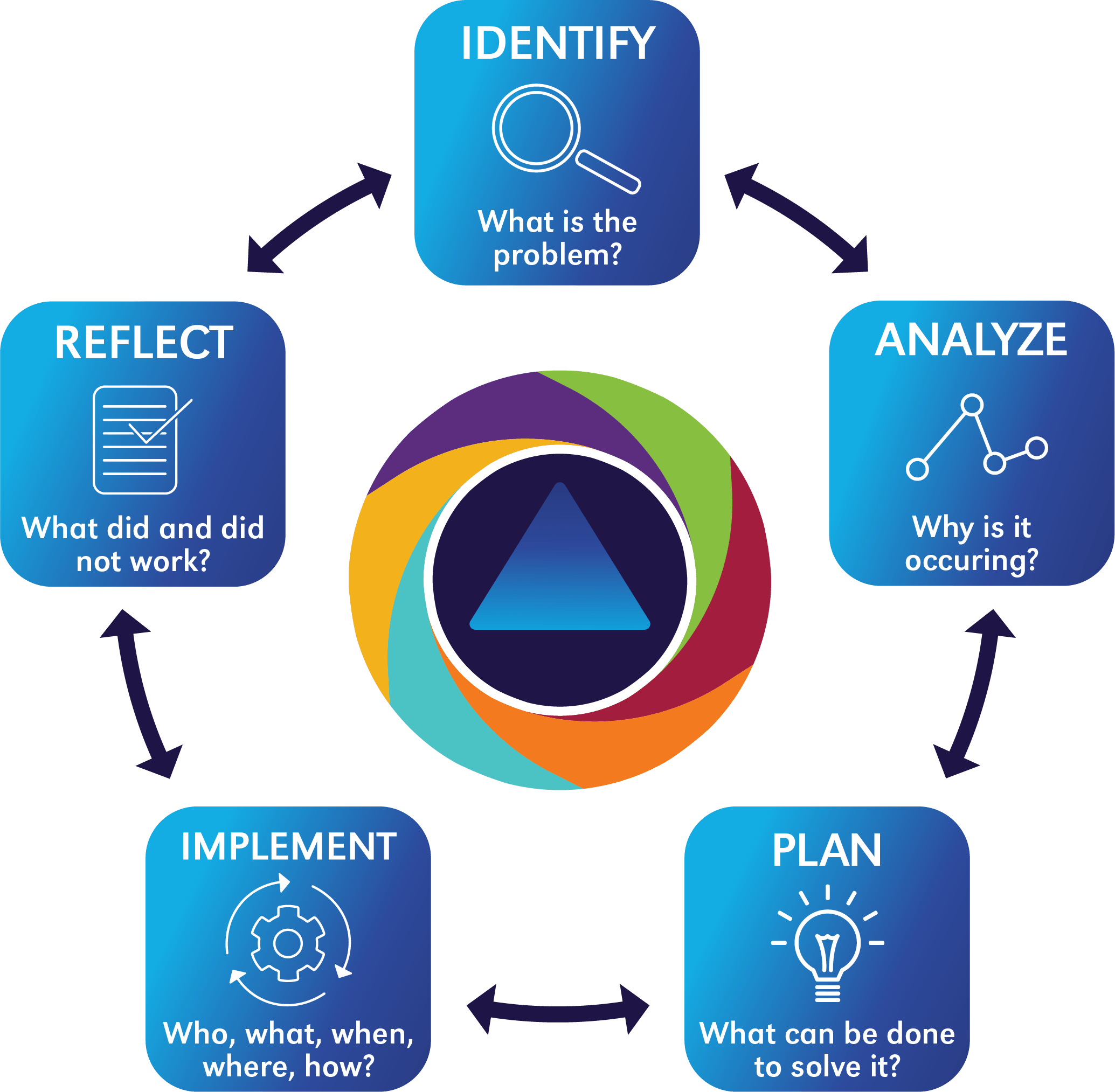
Promoting Social-Emotional Competence to Support All Children
Overview
The Pyramid Model helps ensure that all children experience supportive learning environments that promote positive social emotional growth and development. The approach offers tools to help educators identify and support infants and young children if persistent, challenging behaviors occur.
The Pyramid Model’s evidence-based practices fit within the MTSS framework and its tiers closely align with the MTSS Essential Elements. This alignment allows educators to implement the Pyramid Model seamlessly in their work and provides a platform to build on the social-emotional and behavioral structures they already have in place.
Content adapted from Pyramid Model Australia and the National Center for Pyramid Model Innovations.
Pyramid Model Tiers
Foundation: Effective Workforce
Foundation supports all of the tiers in the model. This foundation is strengthened by the systems and policies that ensure a workforce is able to adopt and sustain the model’s evidence-based practices.
Tier 1: Nurturing Relationships & Supporting Quality Environments
Tier 1 offers universal support for all children.
Tier 2: Targeted Social-Emotional Supports
Tier 2 includes the strategies needed to support children at-risk for challenging behaviors.
Tier 3: Intensive Intervention
Tier 3 includes rigorous supports and interventions needed for a small number of children with persistent behavioral challenges.
Linking the Pyramid Model and NeMTSS
Within NeMTSS, the Pyramid Model is a conceptual framework of evidence-based practices for promoting young children’s healthy social and emotional development. In short, the Pyramid Model is PBIS for early childhood. Pyramid implementation is supported by the Essential Components, much like NeMTSS implementation is supported by the Essential Elements. The chart below highlights some of the connections between Pyramid Essential Components and NeMTSS Essential Elements.

Who can use the Pyramid Model?
- Early childhood professionals (including community child care providers)
- Early intervention professionals
- Educators and teachers
- Mental health professionals
- Families and caregivers
- Other professionals
Where can the Pyramid Model be used?
- School-based programs
- Community-based child care centers
- Home-based child care settings
- Head Start programs
- Other settings
The Pyramid Model is being implemented in communities across Nebraska with support from the Nebraska Department of Education and Rooted in Relationships, the Nebraska Children and Families Foundation’s early childhood mental health initiative.
Content adapted from Pyramid Model Australia and the National Center for Pyramid Model Innovations.
Why it’s Essential
The Pyramid Model promotes educators’ competence and confidence to address the social, emotional and behavioral outcomes of young children from birth to age five.
Other benefits:
- Addresses disparities in discipline practices
- Promotes family engagement
- Supports data use for decision-making
- Fosters inclusion of children with, and at-risk for, developmental delays and disabilities
Implementation and Support
Programs and communities that implement the Pyramid Model effectively use the evidence-based practices and develop a sustainable infrastructure to support the use of those practices.
Implementation Infrastructures:
Programs wanting to implement the Pyramid Model have two infrastructure models to choose from: Community-wide implementation or program-wide implementation.
- Community-wide implementation
Ongoing coordination, collaboration and communication across sectors impacting early care and education within the community. - Program-wide implementation
Ongoing coordination, collaboration and communication within the program.
Benchmarks of Quality
Once the program decides whether they want to implement this evidence-based practice within their community or program, they will focus their efforts on the Benchmarks of Quality. The Benchmarks of Quality is a fidelity tool that measures whether programs are implementing the Pyramid Model to fidelity.
The following bulleted items are critical elements that fall under the Benchmarks of Quality. Strong evidence of these critical elements leads to the program’s fidelity in implementing this evidence-based practice.
Critical Elements:
- Leadership team
- Staff buy-in
- Family engagement
- Program-wide expectations
- Classroom implementation
- Professional development and staff support plans
- Procedures for responding to challenging behavior
- Monitoring implementation and outcomes
For Family Child Care settings, refer to the Family Child Care Homes (FCCH) Benchmarks of Quality.
Training
The Pyramid Model is a proven system for helping educators guide the social-emotional development of young children while improving their ability to learn and self-regulate challenging behavior. These six-hour, in-person modules promote nurturing relationships between staff and children. They equip educators with capabilities and confidence that increases their effectiveness, job satisfaction and longevity.
Nebraska Pyramid Module Series:
- Module 1a: Promoting Children’s Success: Building Relationships
- Module 1b: Creating Supportive Environments
- Module 2a: Intentional Teaching, Friendship Skills, and Empathy
- Module 2b: Emotional Literacy & Problem-Solving
- Module 3a: Intensive Interventions: Back to the Basics
- Module 3b: Intensive Interventions: Developing a Behavior Support Plan
View the Nebraska Pyramid Module Training Matrix.
ePyramid Modules:
The Birth–Five ePyramid Module package is evidence-based and aligned with the in-person Nebraska Pyramid Module Series. It includes a series of 17 online video lessons accompanied by downloadable tools and templates. See ePyramid Module package options.
Coaching
To sustain Pyramid Model practices, coaching must be paired with professional learning. A train-coach-train model helps educators implement and sustain the practices learned.
The identified Internal Coach is associated with the program(s) and provides coaching to teachers and other caregivers working directly with children and families to implement Pyramid Model practices and strategies.
The goal in all settings is to collaborate with, and support the coachees, to implement Pyramid Model practices, and to assist coachees in achieving positive outcomes for the children and families in the programs they serve.
Coach Trainings:
- Nebraska Early Childhood Coach Training
- Pyramid Coach Training
- TPOT Reliability Training
- TPITOS Reliability Training
- Coach Booster Sessions
See upcoming events for training details.
Implementation Support
Interested in implementing the Pyramid Model? Early Childhood Pyramid Implementation Facilitators are available to provide support, including:
- Facilitating leadership team meetings to complete readiness measures and the Benchmarks of Quality.
- Providing consultation, facilitation, system development, including action planning and fidelity assessment services to assigned region.
- Providing training and technical assistance opportunities for regional team members, school district, ESU and community professionals.
- Promoting and assisting in community-wide implementation of the Pyramid Model.
- Offering resources and strategies to support educators.
Contact Us
Reach out to your Pyramid Implementation Facilitator:
Region 1: Amy Colwell, amy.colwell@esu6.org
Region 2: Kayla Parr, kparr@esu3.org
Region 3: Kary Pfeil, kpfeil@esu1.org
Region 4: Libbie Puncochar, lpuncochar@esu10.org
Region 5: Alison Place, aplace@esu13.org
Data for Decision-Making
Data decision-making is a foundational element of the Pyramid Model. State leadership teams use data decision-making when examining statewide implementation components and outcomes for local programs, practitioners and children. Programs use data decision-making to examine their implementation of the Pyramid Model, practitioner implementation of Pyramid Model practices, and outcomes for children and families.
The following tools and resources are available to help programs use data to assess how effectively the Pyramid Model is being implemented.
Benchmarks of Quality (BoQ)
An assessment and progress monitoring tool to examine program-wide implementation.
Who uses the tool?
- Leadership team
Teaching Pyramid Observation Tool (TPOT)
A tool administered by a reliable observer to assess teachers’ current status in implementing the Pyramid Model practices and to identify practices to strengthen.
Who uses the tool?
- Leadership team
- Coaches
- Educators
Teaching Pyramid Infant Toddler Observation Scale (TPITOS)
An instrument administered by a reliable observer that focuses on the direct observation of adult behaviors and environmental arrangements specific to supporting the social-emotional development of infants and toddlers.
Who uses the tool?
- Leadership team
- Coaches
- Educators
Inventory of Practices for Promoting Social Emotional Competence
This inventory encourages individual self-reflection, opportunities for teaming between classroom teachers, mentor coaches, supervisors, site directors and other administrators, and promotes effective practices for direct service staff.
Who uses the tool?
- Leadership team
- Coaches
- Educators
Coaching Documentation System
The coach records data regarding the implementation of a Pyramid Model Practice or specific action plan step.
Who uses the tool?
- Leadership team
- Coaches
- Educators
Child-Level Data
Data used to provide a baseline, monitor child response to intervention and identify children who may need additional support. Individual programs identify tools and expectations of teachers’ use of these tools. (e.g. Teaching Strategies GOLD, Functional Behavior Assessment, Behavior Incident Report, Ages and Stages – Social Emotional, Attendance, Suspension and Expulsion)
Who uses the tool?
- Leadership team
- Coaches
- Educators
Family Resources
Daily Visual Schedule for Families
Help Us Have a Good Day! Positive Strategies for Families
Help Us Stay Calm | Strategies to Help You and Your Child During Challenging Behavior
Provide Frequent Positive Attention
Provide Help Once Your Child is Calm
Setting Clear Behavior Expectations




